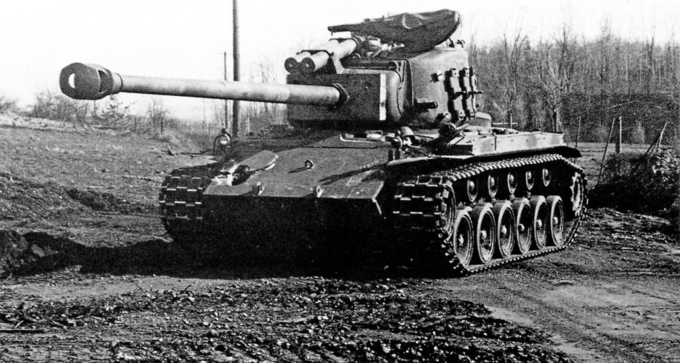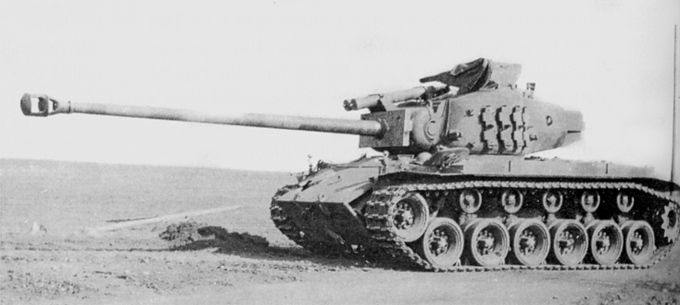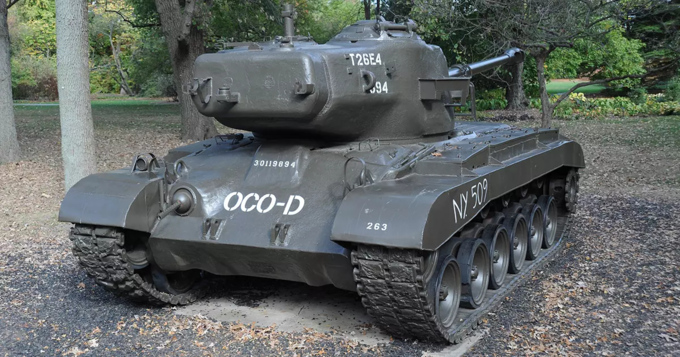Of the tanks in the US Army during World War II, perhaps none had as much unique personality as the T26E1-1 "Super Pershing." With the tacked-on applique armor, the tank looks like something out of a steampunk setting, yet the tank still represents the most formidable tank the US Army brought to the European Theater.
Development
The M26 Pershing helped the American armored forces by bringing the 90 mm Gun M3 into service on a tank mount, as opposed to the M36, which entered service prior to the M26 but was not considered a tank by the US Army. The gun was similar in performance to the German Tiger I's 8.8 cm KwK 36 cannon, but Army Ordnance wanted something to match the more powerful 8.8 cm KwK 43 cannon on the Tiger II. The development to match this cannon made the T15 90 mm gun. The gun was 73 calibres long, compared to the 90 mm Gun M3's 53 calibre length. The first guns produced were called the T15E1 and had large, fixed ammunition. To test the gun's viability in the tank, the gun was mounted onto the very first production T26, T26E1 tank serial #1, registration #0103292, with the conversions done by the Wellman Engineering Company. This upgraded tank was titled the T26E1-1 by means of a painted-on designation on the turret's left side to distinguish the design, although this title was not official, and few, if any, sources refer to it as such. The extreme length of the T15E1 gun barrel caused the manufacturers to add a very prominent counterbalance on the mantlet, which could be seen on the left side of the turret when facing it. The T26E1-1 tank was sent to Aberdeen Proving Grounds on 12 January 1945 for testing.
In March 1945, following the Aberdeen tests, the T26 tanks mounting the T15 gun were officially classified as the T26E4. As such, the mentioned T26E1-1 would be classified as the first of the T26E4 models, with an initial procurement plan for 1,000 more units. The first T26E4 (hereafter called T26E1-1) would be the only M26 model with the T15 gun to see service in Europe. Among the troops, the T26E1-1 in Europe would be known by its eponymous name, "Super Pershing," when compared to the standard M26 Pershing.
Combat usage
The T26E1-1 "Super Pershing" was sent to Europe, arrived on 15 March 1945, and was assigned to the 3rd Armored Division. In its introduction, the "Super Pershing" was given additional armor by the maintenance crew to keep it up to date against the heavier German tanks. The front hull had two large pieces of metal welded onto it, each 38 mm in thickness, with a space in between the metal pieces. These metal pieces were sloped more than the hull armor it was over. An additional 80 mm armor piece from a Panther turret was welded onto the T26E1-1's turret mantlet. The T15E1 gun had much promise to the crew when using the tank, as the weapon could reliably penetrate the frontal hull of a Panther tank, a feat not many other American tank guns could claim at the time.
The T26E1-1's performance in battle is primarily based on the accounts of John P. Irwim, the tank gunner of the only active "Super Pershing" in the war. He mentions three prominent combat actions with the T26E1-1, each one destroying the enemy with little difficulty. Records show that the T26E1-1 destroyed three tanks and captured one after an extended firefight that left the opposing tank out of ammunition. The T26E1-1 allegedly fought against a Tiger during the Battle of Dessau on April 21st, which ended when the Tiger commander had their tank climb debris, allowing gunner Corporal John P. Irwin to disable the German tank with one shot. However, no evidence supports Irwin's claim that he encountered a Tiger in Dessau, as the nearby Tiger tank units had been destroyed or surrendered by Irwin's encounter date.
Legacy and similar vehicles
The T26E1-1 continued as an idea long after the war was over, with the subsequent development of arming the long 90 mm cannon in the T26E3 tank models, but the cannons now used the new two-piece ammunition gun T15E2 rather than the one-piece one in the T15E1 after it was found that the long 50 inch rounds made loading prohibitive in the M26 turret. Twenty-five of these tanks were built and were designated the T26E4. Another development was to convert normal M26 Pershings to mounting the T54 cannon, another development of the T15E1, which featured shorter ammunition. These tanks were redesignated the M26E1, but work was halted due to issues with the guns and a cut in project funds.
Bibliography
- Hunnicutt, R.P. Pershing: A History of the Medium Tank T20 Series U.S.A.: Feist Publications, 1971
- Irwin, J. P. (2002). Chapter 9. In Another River, Another Town.
- Zaloga, S.J. (2017). "The Super Pershing in Combat". In Pershing vs Tiger: Germany 1945.




